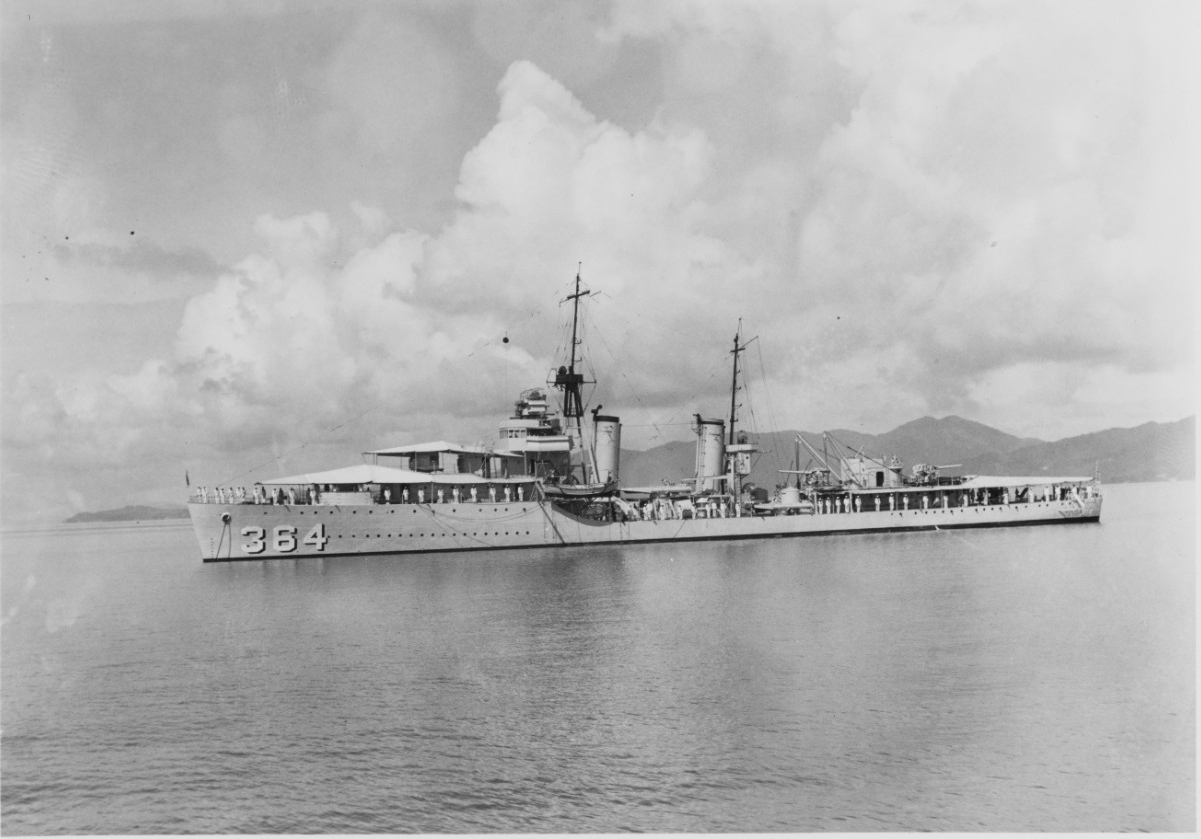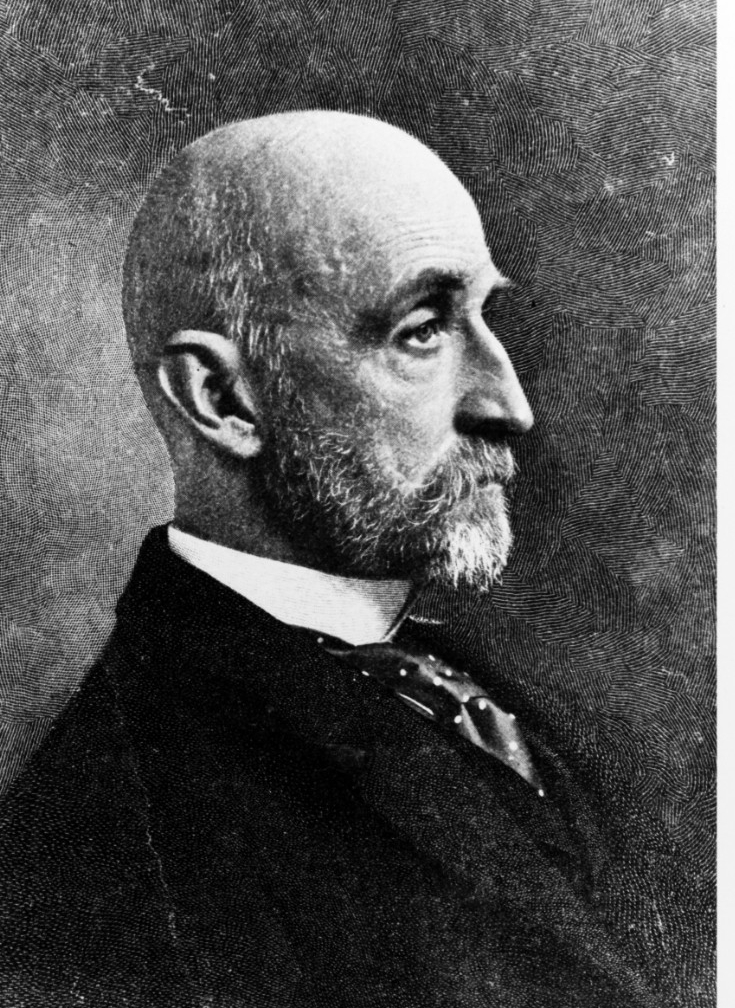Mahan II (DD‑364)
1936–1944
Rear Adm. Alfred Thayer Mahan, born 27 September 1840 at West Point, N.Y., graduated from the Naval Academy in 1859 and served with the South Atlantic and western Gulf Blockading Squadrons during the Civil War. Later appointed President of the Naval War College, he served two tours, 1886‑89 and 1892‑93.
His widely admired study, "The Influence of Sea Power Upon History," and his many other well reasoned and scholarly books and articles have made a major impact upon geopolitical thought and modern theories of world strategy and have established Mahan's place among history's great thinkers.
Having retired in 1896, he was recalled during the Spanish‑American War to serve on the Naval Strategy Board. Among his many activities during the years which followed were service as a delegate to the First Peace Conference at The Hague; as a member of the Board of Visitors, Naval Academy, 1903; with the Senate Commission on Merchant Marine, 1904; as a member of the Commission to Report on the Reorganization of the Navy Department; and as a lecturer at the Naval War College. He died at Washington, D.C. 1 December 1914.
For the full biography also see Mahan I (Destroyer No. 102) 1918–1930
II
(DD‑364: displacement 1,880 tons; length 341'3"; beam 34'11"; draft 10'6"; speed 35 knots; complement 219; armament 5 5-inch, 4 .50 caliber machine guns, 12 21-inch torpedo tubes; class Mahan)
The second Mahan (DD‑364) was laid down on 12 June 1934, at Staten Island, N.Y., by United Dry Docks, Inc.; launched on 15 October 1935; sponsored by Miss Kathleen H. Mahan, great‑granddaughter of Rear Adm. Alfred T. Mahan; and commissioned on 18 September 1936, Cmdr. John B. Waller in command.
Mahan steamed for her shakedown cruise from New York on 16 November 1936, conducting training operations and a tour of ports in the Caribbean Sea and South America. She participated in a dress review of U.S. Navy ships and those of foreign nations by Brazilian President Getúlio Vargas at Rio de Janiero, held on 25 December, during the visit to Brazil of Secretary of State Cordell Hull.
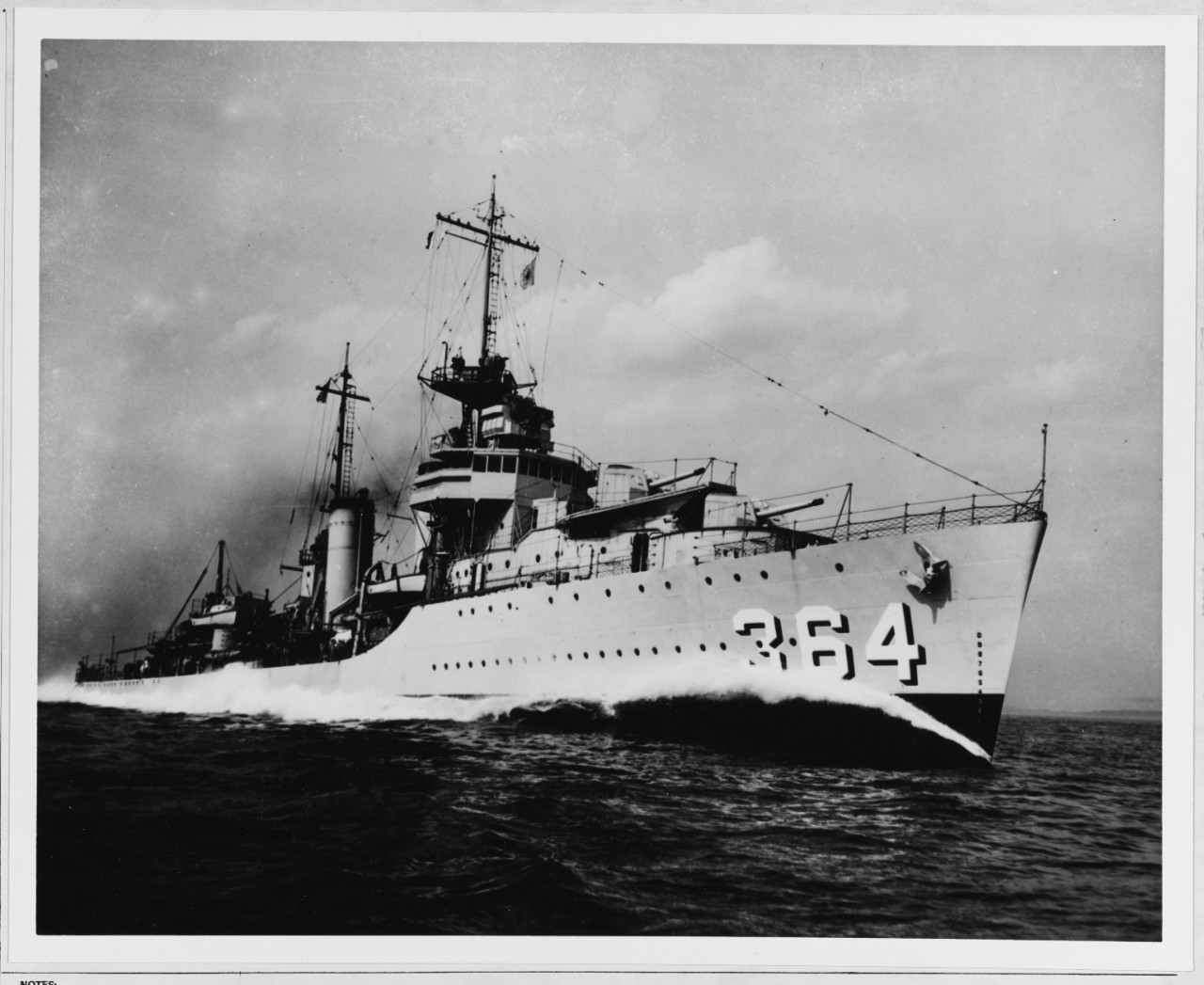
Returning to New York on 15 January 1937, Mahan operated along the eastern seaboard periodically until July, before departing for the west coast of the U.S. While en route in July, she assisted in attempts to free the light cruiser Omaha (CL-4), grounded at Castle Island, Bahamas, on the 19th. After ten days, with the employment of tugs pulling the cruiser while Mahan and other destroyers circled in an effort to create waves, Omaha successfully floated free. She returned to Norfolk for repairs while Mahan continued on for San Pedro, California.
Arriving at San Pedro on 14 August 1937, Mahan later got underway at various periods throughout the year to conduct fleet training operations out of San Diego, Calif., until the destroyer’s departure for Hawaii in mid-1938. Aside from periodic underway training exercises off Oahu and the west coast of the U.S., Mahan participated in Fleet Problem XIX (April–May 1938), providing training in the deployment of submarines, destroyers, and aircraft in scouting and attack, as well as the conduct of a major fleet battle. Given permission to operate the fleet carriers independent of the battle force, Adm. Ernest J. King used the flexibility to launch air attacks against Pearl Harbor and Mare Island Navy Yard in California, testing the capabilities of the Hawaiian Defense Force, as well as those on the mainland.
Mahan continued her operations with the Fleet out of Pearl Harbor as the year 1941 came to an end. On 27 November 1941, with tensions high between the U.S. and Japan over the latter’s continued aggression in China, both U.S. Navy and Army commanders in Hawaii received a “war warning” from Washington. As part of last-minute plans to reinforce Pacific bases, Lexington (CV-2) embarked Marine Scout Bombing Squadron 231 on 27 November and sailed for Midway in Task Force (TF) 12, Rear Adm. John H. Newton, commanding.
Mahan was steaming in company with Lexington and the heavy cruisers Chicago (CA-29), Portland (CA-33), Astoria (CA-34); and destroyers Porter (DD-356), Drayton (DD-366), Flusser (DD-368), and Lamson (DD-367) when she received word on 7 December 1941 that Pearl Harbor was under attack. The task force reversed course for Hawaii. Upon receipt of a second message ordering the force to “Assume that Japanese raiding forces left position 200 miles south of Pearl Harbor for Jaluit…intercept and destroy,” Mahan changed course again, and TF 12 began searching in vain for the Japanese carriers.
On 8 December 1941, heavy cruiser Indianapolis (CA-35) joined Lexington and Destroyer Squadron (DesRon) 1, to form TF 11, under Vice Adm. Wilson Brown. After receiving word of a good sound contact, Mahan split off from the group to launch a depth charge attack. Sighting no debris in the water, she rejoined the task force. Lexington launched her aircraft to conduct sweeps throughout the area on the ninth and 10th, and again over the next two days. With Porter and Lamson in company, Mahan left the task force and proceeded to Pearl. Upon arrival, the crew expressed astonishment, disgust, and anger at seeing the destroyed fleet in the harbor. Operating in the waters off Oahu until Christmas day, Mahan embarked 105 marines for transportation to Johnston Island. Ships company spent the remainder of the holiday readying her for departure at 0830 on 26 December. After arriving at Johnston Island on 3 January 1942, she disembarked marines. Mahan steamed back immediately to Hawaii, arriving on 9 January to await orders.
Remaining at Pearl Harbor until 10 January 1942, Mahan got underway screening the oiler Sabine (AO-25) in company with destroyer Cushing (DD-376) and seaplane tender Curtiss (AV-4). Four days later, while steaming off Oahu, she received orders to screen Sabine to Pago Pago, Samoa. On 18 January, she crossed the equator and received King Neptune, initiating and welcoming Pollywogs into the Ancient Order of the Deep. Continuing to proceed to Samoa, Mahan arrived there on 20 January. Three days later, she received orders to join TF 17. After joining the task force, she took up station as part of the anti-submarine screen as the formation steamed for Pearl, arriving on 6 February.
After sortieing with seaplane tender Tangier (AV-8) on 11 February 1942, and steaming briefly with Task Group (TG) 11.9, Mahan was detached from the group and proceeded to Palmyra and then Christmas in the Canton Islands. Arriving at Canton on the 24th, she took up a patrolling station off the island, remaining in the area until relieved on 24 March. After steaming back to Hawaii, she made way for San Pedro on 5 April for an overhaul. Completely refitted by 30 April, Mahan conducted calibration runs from 1-8 May, before proceeding independently to join TF 1. For the remainder of the month, she operated off the west coast. On 1 June, as part of TG 11.1, she departed San Diego for Pearl Harbor. For the next four-and-one-half months, Mahan operated on routine escort missions off the west coast and in Hawaiian waters.
On 16 October 1942, Mahan steamed out of Pearl with TF 16, heading for the South Pacific. Three days later, Lamson and Mahan left the formation, as Destroyer Division (DesDiv) 9, proceeding to conduct a raid on Japanese patrol vessels south of the Gilbert Islands. Shortly after 1300 on 22 October, a Kawanishi E7K Type 94 reconnaissance seaplane circled the destroyers at an extreme range, but did not attack. Ten minutes later, the destroyers sighted the masts of a small enemy schooner.
Closing the range, Lamson and Mahan opened fire, scoring several direct hits and sinking the vessel. An hour later, a Japanese armed naval auxiliary of 8,000 tons appeared. Immediately taken under fire, the enemy vessel engaged the destroyers in a running gun battle. Expert marksmanship by the destroyer crews sent the auxiliary to the bottom, while Lamson and Mahan received no damage. As the Japanese vessel slipped beneath the waves, the E7K dive-bombed Lamson, dropping two bombs wide of the ship. Both destroyers opened fire on the aircraft, and after two more bombs dropped and missed, the enemy seaplane retired from the area. This marked Mahan’s first air and surface action with the enemy. The next day, both ships rejoined TF 16.
After joining TF 61 (composed of TF 16 and 17) to steam north on 24 October 1942, Japanese aircraft attacked the group north of the Santa Cruz Islands. During the following Battle of Santa Cruz (25–27 October), Japanese bombs and torpedoes struck carriers Hornet (CV-8) and Enterprise (CV-6), as well as battleship South Dakota (BB-57). Destroyer Porter (DD-356) sadly took a torpedo from a battle-damaged and ditched TBF. Deemed beyond salvage, she was scuttled by destroyer Shaw (DD-373)]. Hornet, hit by several Japanese bombs (and crashing enemy aircraft), sank with the loss of 140 of her 2,200 crewmembers, leaving the damaged Enterprise the only Allied carrier in the Pacific.
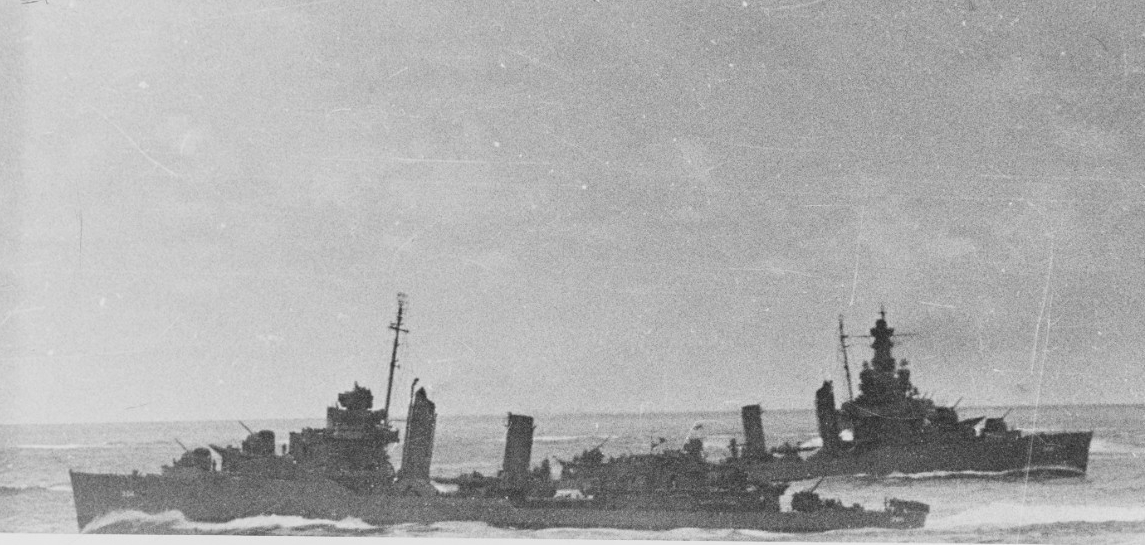
Mahan received credit for shooting down a pair of Nakajima B5N Type 97 carrier attack planes, two Aichi D3A1 Type 99 carrier bombers, and another unidentified aircraft during the battle. On 30 October 1942, while maneuvering to avoid a possible submarine attack, Mahan collided with battleship South Dakota, resulting in severe damage to the destroyer’s bow. Proceeding to Nouméa, New Caledonia, for repairs, Mahan received a temporary bow. With the work completed on 22 November, the destroyer conducted high-speed trial runs to test the replacement bow, departing Nouméa for Pearl Harbor in company with San Francisco (CA-38), Sterett (DD-407), and Conyngham (DD-371), on 24 November. Arriving at Pearl Harbor on 4 December, Mahan went into dry dock to receive her permanent bow.
With her new bow tested and secured, Mahan got underway from Pearl on 9 January 1943, setting a course for Bora Bora. Arriving at Vaitape Harbor at 0927 on 16 January, she stood out to act as convoy escort for Task Force (TF) 19 the next day. Taking up station in the screen, she proceeded to Nouméa, before escorting another smaller convoy of the task force to Fiji. Mahan spent the remainder of January-February operating as a screen for small convoys steaming between New Hebrides, New Caledonia, and Fiji. During March, Mahan patrolled off New Caledonia. On 25 March, Cmdr. Rodger W. Simpson, commanding, stood relieved by Lt. Cmdr. James T. Smith.
On 7 April 1943, the destroyer sortied with TF 10, operating out of Nouméa until 18 April. Upon arrival, she got underway with Task Unit (TU) 32.4.5, a transport convoy, and proceeded to screen them to Lunga Point, Guadalcanal, Solomon Islands. After safely reaching their destination, Mahan took up a patrolling station off the island, awaiting the reformation of the task unit for the return trip to Nouméa.
Upon arrival on 26 April 1943, Mahan remained anchored until 8 May, getting underway as a screen for the U.S. War Shipping Administration troopship Cape Flattery en route to Gladstone, Australia. From 15 May–16 June, she operated in Australian waters in company with TF 74, conducting tactical exercises. Getting underway for Milne Bay, New Guinea, on 16 June, she performed screening duties until 2 July. The next day, in company with TG 76.5, Mahan stood out from Milne Bay for Kiriwina Island, escorting TG 76.2 before returning to New Guinea.
Her duties kept her steaming between Milne Bay and Kiriwina Island until 9 July 1943. Getting underway to Townsville and Brisbane, Australia, Mahan escorted destroyer Drayton and troop transport Henry T. Allen (AP-30). Upon reaching Brisbane, she made way for Port Moresby, New Guinea, with Henry T. Allen. After participating in the landing operations on 9 August at Nassau Bay with DesRon 5, Mahan returned to Milne Bay.
After securing from her role at Nassau Bay, Mahan performed screening duties, patrol assignments, and training exercises until 21 August 1943. Getting underway with Perkins (DD-377), Smith (DD-378), and Conyngham, she took part in the shore bombardment of Finsch Harbor, New Guinea, on 22–23 August, returning to Milne Bay on the 24th to resume her patrolling station. In preparation for the landings at Lae, New Guinea, on 4 September, Mahan began a shore bombardment on “Red Beach,” 15 miles east of Lae. She expended 300 rounds of 5-inch ammunition while shelling the beach. During the night of 5-6 September, alongside Perkins, Smith (DD-378), Flusser (DD-368), and the tug Sonoma (AT-12), she carried out assigned duties, screening astern of a convoy of seven LSTs. At this time, the group was about 35 miles south of Red Beach.
Throughout the night, all the destroyers had radar contact with enemy aircraft, and at 2045, an unidentified Japanese plane strafed Smith, stationed on the port beam of the formation. At 2125, Mahan made radar contact with another unidentified enemy aircraft, ten miles from her position. Eight minutes later, the destroyer’s guns opened fire, as the Japanese plane continued to close the ship. As it neared only 3,500 yards distant, the pilot suddenly changed course, flew parallel to Mahan and out of sight, causing no damage.
The next night (7-8 September 1943), while still operating as part of the covering force for the Allied forces operating in the Huon Gulf and Red Beach, Mahan was again attacked by unidentified Japanese aircraft. The planes “disappeared from radar screens after firing,” and Mahan’s crew stood down from general quarters. After repelling the air attack, the group proceeded to bombard supply areas at a Japanese airstrip near Lae. Mahan commenced firing her main battery at 0334, bombarding the beach at Lae for seven minutes before ceasing fire. After refueling at sea, Mahan steamed alongside Australian ammunition supply vessel HMAS Yunnan (FL.151) to take on stores, especially shells for her 5-inch guns, before anchoring at Buna until 9 September.
At 0127, on 10 September 1943, Mahan steaming alongside Perkins on antisubmarine patrol attacked an enemy submarine with depth charges. Nine minutes later, Smith also attacked with her own depth charges. Securing from general quarters, Mahan formed a scouting line with Perkins, Flusser, and Smith before engaging in landing operations at Lae. After anchoring at Buna to take on fuel, the group escorted LCIs (landing craft, infantry) into the beach at Lae on 12 September. Despite Mahan’s port beam coming under enemy machine gun fire at 1845, the LCIs reached the beach four hours later. With no reported injuries, she resumed patrolling the area off Huon Gulf and Red Beach.
While escorting three LSTs returning from landing operations near Finschafen, New Guinea, eight twin-engine Mitsubishi G4M Type 1 land attack planes (Betty) flew in low over the water to attack the formation, including six to strike Mahan and Reid. Opening fire with her main battery and machine guns, Mahan zigzagged while the attacking aircraft dropped torpedoes at an approximate range of 1,000–1,500 yards. The destroyers used evasive maneuvering to dodge the torpedoes, all while keeping up a steady rate of anti-aircraft fire. One bomber exploded off the starboard bow, as the second crossed Mahan’s bow before going down in flames off the port side. The third bomber also crashed into the sea. An enemy fighter (possibly a Zeke) flew in to strafe Mahan, wounding GMC Donald R. Bertrand in the left leg, as well as AS3c Curtis L. Stallings in the left thigh and abdomen.
At 1309, Mahan stopped to pick up 1st Lt. Vivian A. Cloud, USAAF, a Lockheed P-38 Lightning pilot from 432nd Fighter Squadron (“Satan’s Angels”), 475th Fighter Group, Fifth Air Force. Lt. Cloud managed to shoot down both a Betty and Zeke before he was himself shot down, bringing his tally of downed enemy aircraft during the war to five (giving him “ace” status).
Operating out of Buna on patrolling and escort duties with elements of TF 76 from October-November 1943, Mahan engaged the enemy on three separate occasions. In the early morning hours of 20 October, while conducting antisubmarine searches with TU 76.6.5, enemy aircraft attacked. Dropping several clusters of bombs upon the ships of the task unit none fell closer than 1,000 yards of Mahan.
In company with Lamson, Flusser, and Shaw, the destroyers proceeded from Buna to Vitiaz Strait to conduct a submarine search and bombard Japanese installations at Sio, New Guinea. At 2000 on 28 November 1943, Mahan entered the submarine search area and went to general quarters. After a five-hour search revealed no surface or sound contacts, the group formed in column and commenced the approach on the installations at Sio. After bombarding the Japanese for a half-hour, Mahan and her task group steamed for Madang, New Guinea, to destroy enemy installations.
At 0110 on 30 November 1943, Mahan was in position to commence the shelling of enemy positions encountering no opposition from the Japanese; the ships continued thoroughly blasting their pre-arranged targets. Upon completion of her mission, Mahan departed for Milne Bay. While moored at Milne Bay, the destroyer engaged in shore bombardment exercises in preparation for future actions. On 14 December, she joined Flusser before proceeding to Arawe, New Britain, to conduct a shore bombardment of enemy installations. After expending all of her ammunition, she made way for Milne Bay.
Getting underway on 1 January 1944, Mahan steamed for Buna anchorage, joining Reid, Flusser, and Beale, escorting Echelon M2 of the Saidor Naval Attack Force. Her 1944 deck log poem exemplified the crew’s morale for the coming year:
At 0320 preparations were made to get underway
and perhaps make a raid. At 0350, underway on time,
proceeded on signal to take station inline. The Japs know
we’re coming but no one has fear this isn’t the beginning
of a Happy New Year.
The next morning, the group arrived off Saidor, New Guinea, and the destroyers detached from escort duty to prepare for shore bombardment. With the mission completed, Mahan made way for Cape Sudest, Buna. After a second escort mission, she conducted a shore bombardment action at Gali, New Guinea, on 8 January 1944. After returning and anchoring in Milne Bay, Mahan received orders on 11 January to proceed to Sydney, Australia, for the next week. Underway the next day, she made way for Cape Sudest, en route to Sydney. Arriving in Sydney on 15 January, the destroyer performed escort duty between New Guinea and New Britain for the next 27 days.
Anchoring at Cape Sudest from 2-6 February 1944, Mahan got underway with Flusser at 1921 to escort Echelon B-21 to Cape Gloucester, New Britain. Arriving off Borgen Bay, Cape Gloucester, on 9 February, Mahan commenced patrolling with Flusser and Drayton during unloading operations of LSTs. At 1930, she rejoined Echelon B-21 and made way for Cape Cretin, New Guinea. On 11 February, Mahan steamed with Flusser, Drayton, and Smith escorting three LSTs and a small gasoline tanker to Cape Cretin. A day later, she escorted Echelon M-12 to Saidor and commenced patrolling while LSTs unloaded supplies on the beach.
On 14 February 1944, Mahan arrived at Cape Cretin, completing her escort of M-12. She proceeded to escort Echelon B-22 south to Cape Gloucester, arriving the next day. For the next two weeks, the destroyer performed escort duty between New Guinea and New Britain. Prior to making way for Cape Sudest, Mahan received on board 72 soldiers of the 1st Cavalry Division, U.S. Army. A day later, attached to TU 76.1.3, Mahan got underway at 0830 with other destroyers of the task unit, en route for the Admiralty Islands to take part in the shore bombardment of Los Negros Island.
While underway on 17 February 1944, S2c D.M. Kirkland received injuries of a small laceration of the scalp and a superficial scratch on his right arm, sustained in a fight on the mess deck with S2c John E. Lawson, Jr. The next day, at 0915, the crew mustered on stations for captain’s mast. Found guilty of striking another enlisted person, S2c Lawson received five days bread and water. At 0725 on 29 February, the task unit arrived off Hyane Harbor, Los Negros Island. The destroyers proceeded to each of their support points to conduct bombardments on enemy targets. Securing from her fire mission on 1 March, Mahan steamed back to Cape Sudest with the task unit. The Battle of Los Negros Island ended three days later, an allied success.
Making way to Buna, Mahan moored in the harbor from 6-10 March 1944. On 13 March, she stood out for Cape Sudest, joining TU 76.1.55. Split into two sections, Mahan joined the first section with fellow destroyers Stevenson (DD-645), Swanson (DD-443), Wilkes (DD-441), and Roe (DD-418), before proceeding en route to Admiralty Islands while escorting seven LSTs. Arriving off Seeadler Harbor at 0900 on 16 March, the destroyers patrolled the harbor entrance while LSTs proceeded into the harbor for unloading operations. At 2030, as the LSTs came out of Seeadler Harbor, Section One and Section Two, consisting of destroyers Hobby (DD-610), Kalk (DD-611), Gillespie (DD-609), and Reid (DD-369), of TU 76.1.55 formed up and got underway for the return trip to Cape Sudest.
While anchored in Oro Bay from 19-20 March 1944, Mahan transferred her ammunition and torpedoes prior to leaving the Southwest Pacific Area for the U.S. Standing out at 1700 on 21 March, she first reported to Commander Third Fleet at Lunga Point, Guadalcanal, for duty as escort to Pearl. Two days later, after arriving at Purvis Bay in the Solomons, she received orders to TU 34.9.1. Mahan arrived to Funafuti Harbor, Ellice Islands, on 1 April. After a short stop at Canton Island on 5 April, the destroyer moored at Pearl Harbor at 1900 on 10 April. After a two-day liberty visit, she stood out for Mare Island Navy Yard, arriving on 18 April for an extensive overhaul, lasting until 18 June. From 19–26 June, she underwent trial runs and adjustment of equipment in San Francisco Bay.
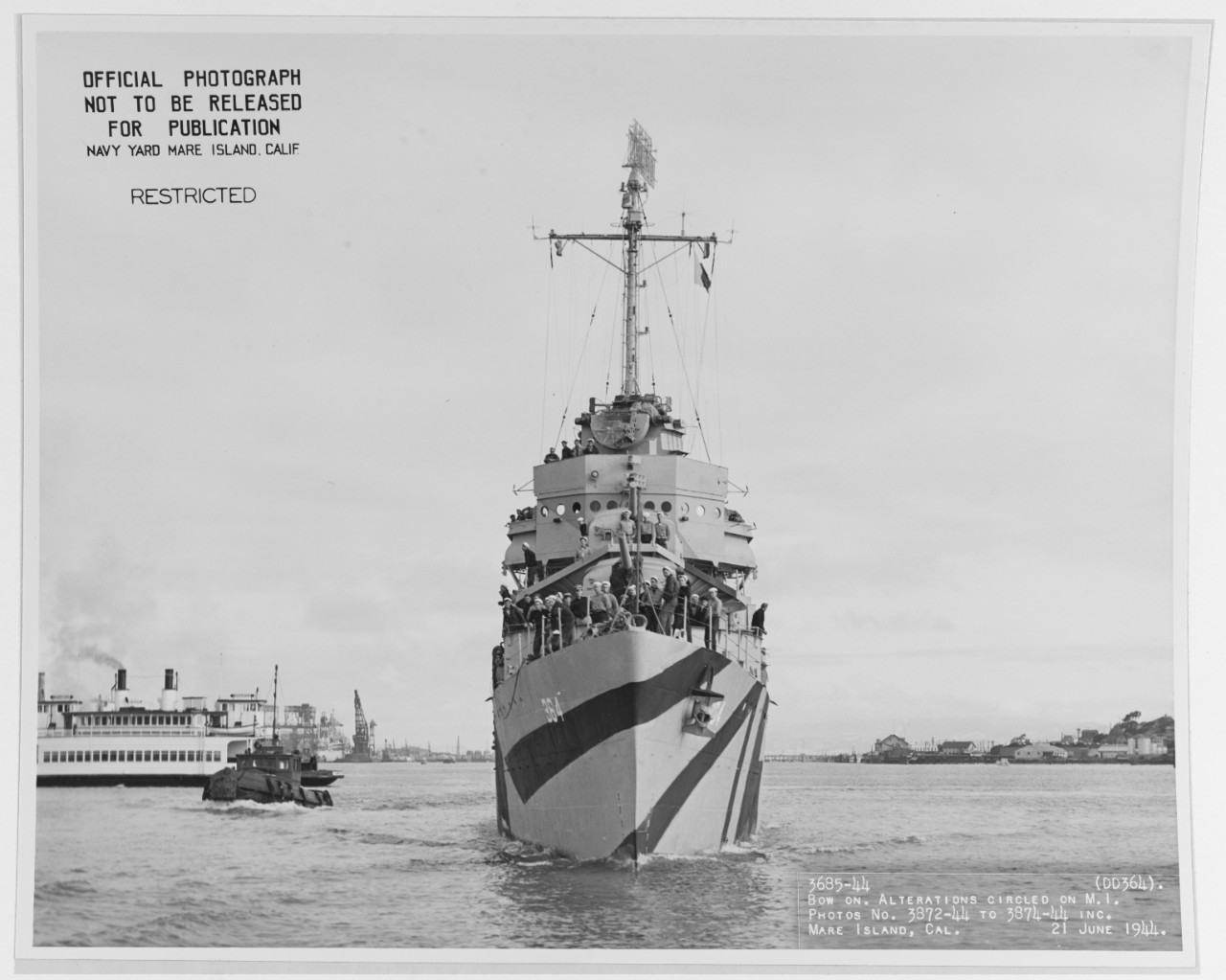
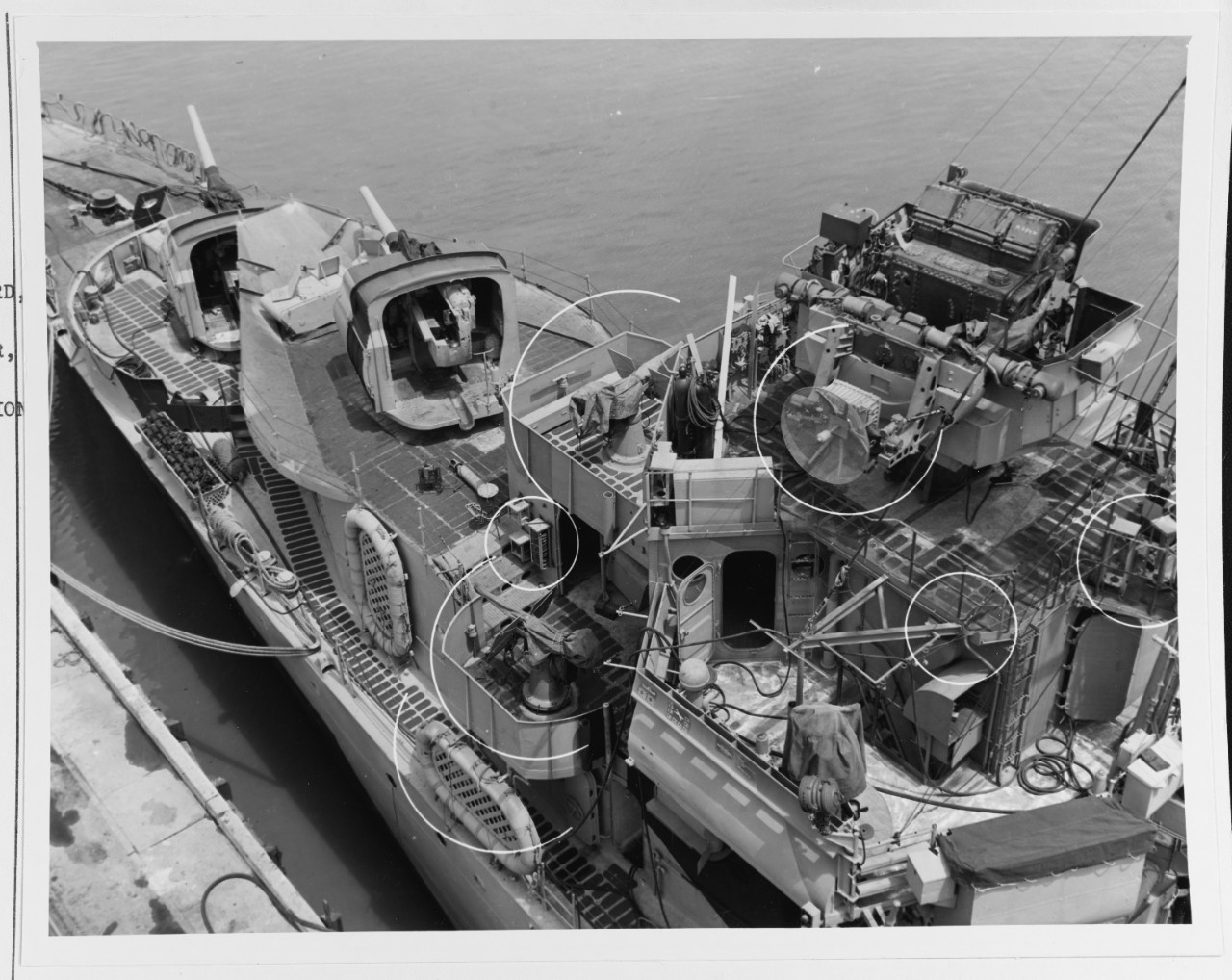
Upon completion of her repairs, Mahan again prepared to reenter the combat zone. Attached to TG 15.1, she stood out for Oahu on 29 June 1944, alongside light cruiser Columbia (CL-56) and Drayton. Arriving in Hawaii at 1015 on 5 July, she immediately engaged in operational exercises from 7-24 July.
Moored at Pearl Harbor Navy Yard from 25 July-5 August 1944, Mahan underwent repairs before getting underway for the next 11 days to conduct training exercises off the coast of Oahu. Standing out on 16 August, she steamed for the Marshall Islands as part of TU 12.3.2, alongside carriers Enterprise, Intrepid (CV-11), and Independence (CVL-22); and destroyers DeHaven (DD-727), Blue (DD-744), and Cushing (DD-797), anchoring off Eniwetok on 24 August. Six days later, she relieved Smith and commenced patrolling off Jaluit Atoll.
While conducting operations in the Marshall Islands, Drayton relieved Mahan on station at 1235 on 4 September 1944. The destroyers entered Majuro Lagoon and moored for minor repairs. Four days later, on 8 September, Mahan got underway at 1606 en route to Eniwetok in company with destroyers Smith, Lamson, and Drayton. At 1600 on 12 September, she joined Smith in a hunter-killer operation, before the mission terminated four days later. The formation steamed on for Eniwetok, Mahan anchoring in the lagoon from 17–19 September. She stood out on the 20th alongside heavy cruisers Chester (CA-27), Pensacola (CA-24), Salt Lake City (CA-25); and destroyers Smith, Conyngham, Drayton, Reid, and Lamson for training exercises.
Mahan got underway at 1521 on 23 September 1944 for Guam; in company with minesweeper Captivate (AM-156), the two ships escorted the U.S. War Shipping Administration troopships of Dutch registry Bloemfontein and Kota Baroe, and U.S. freighters Charles E. Smith and Sheldon Jackson. Four days later, she entered Apra Harbor, and on the 28th, Mahan stood out at 1258 with TU 57.16.15 en route to Eniwetok with escort ship McCoy Reynolds (DE-440). Convoying cargo ships Fort Nassau, Wallace R. Farrington, Cornelius Vanderbilt, and Richard J. Oglesby, she left the convoy at 1604 on 30 September to proceed independently to Saipan.
Arriving at Tanapag Harbor, Saipan, on 1 October 1944, Mahan got underway for Eniwetok at 2154. After arriving at Eniwetok on 5 October, she spent the next three days undergoing repairs. After taking on supplies, she stood out for Kossol Passage, Ulithi, on 12 October. Almost immediately upon reaching her destination, the destroyer made way for Hollandia with DesRon 5. Arriving at Dutch New Guinea on 20 October, she spent the next four days anchored in Humboldt Bay before steaming back to Kossol Passage. A week later, Mahan set course to overtake Echelon Love Six and escort the formation to Leyte Gulf. The group entered San Pedro Bay at 1415 on 29 October. The next day, she got underway at 0234 at various courses and speeds within San Pedro Bay in order to ride out a typhoon. Five hours later, Mahan anchored again, suffering no casualties due to the storm.
On 1 November 1944, DesRon 5 joined TG 77.1 in Leyte Gulf near Surigao Strait to assist fighting off a Japanese air attack. Although successfully driving the attackers off, enemy aircraft continued to be quite active in the general vicinity for a number of days. Mahan received orders on 12 November to report to TG 78.2 for duty, and departed the next day with Conyngham to escort a convoy to Humboldt Bay. Arriving on 24 November, the two ships joined with other ships from DesRon 5 to steam back for Leyte. Once back in the Philippines, the destroyer took up antisubmarine patrols.
Mahan departed from the southern transport area of Leyte Gulf on 6 December 1944, becoming part of the Ormoc Attack Group, TG 78.3, under the command of Rear Adm. Arthur D. Struble. At 0610 on 7 December, three years to the day marking the attack on Pearl Harbor, Mahan received an order to stand out for her antisubmarine patrol line between Culunangar Point, Leyte, and Pilar Point, Ponson Island. Arriving at her station in Ormoc Bay at dawn, the destroyer changed course and proceeded to a fighter-director station five miles north of Pore Island to take up patrol.
At 0943, radar picked up a formation of aircraft sighted ten miles to the east on a southerly course. Suddenly, nine twin-engine Japanese bombers, with an escort of four fighters appeared on the horizon. The order to open fire given, lookouts on board Mahan quickly noticed three U.S. Army Air Force Lockheed P-38 Lightnings overtake the Japanese fighters. In a matter of minutes, two of the Lightnings knocked down three enemy planes. Two of the Japanese bombers, also hit by the P-38s, began smoking when the nearest one to the ship went into a steep banking dive to attack the destroyer. Levelling off at 50 feet above the water off Mahan’s starboard beam, the bomber closed to within 2,000 yards of the ship, headed directly for her bridge.
Mahan’s gunners fired incessantly at the rapidly approaching bomber, scoring several hits and blowing the aircraft apart only some 50 yards from the ship. The second bomber, not far behind the first, and shortly disoriented from the explosion of its wingman, passed over Mahan before turning about and crashing into her, striking between the waterline and the forecastle deck level on the port side, just abreast of the number two 5-inch gun. The kamikaze also tore off the destroyer’s mast, disabling her radar and radio.
Shortly after, the third and fourth bombers also flying towards Mahan both crashed into the sea, brought down by the ship’s accurate gunfire. A fifth suicide plane suddenly hit the struggling destroyer on her starboard side, just behind the bridge at the forecastle deck level, knocking down the forward stack and foremast. The sixth kamikaze struck on the starboard side at the waterline, abreast of gun number two. In only a matter of minutes, three suicide planes severely damaged Mahan, as her crew valiantly fought off further kamikazes threatening to strike.
A seventh enemy bomber pilot streaked in on a strafing run. Hit and aflame from gunfire by the destroyer’s gunners, the burning aircraft struck the water only 200 yards ahead of the ship. An eighth bomber, already shot up by the Lightning pilots, attempted to crash into Mahan, but missed and exploded into the sea instead.
After the ninth and last enemy aircraft passed overhead, Mahan made emergency flank speed in an attempt to reach the vicinity of the other ships of her attack group. Meanwhile, damage control crews on board valiantly struggled to extinguish the fires spreading rapidly through the wardrooms, number one gun shelter, mess compartments, and forward magazines.
After a few minutes, it became apparent that Mahan’s high speed only served to fan the fires, so Cmdr. Earnest G. “Scottie” Campbell decided to stop full. Cmdr. Campbell, a survivor of the sinking of destroyer Perkins on 29 November 1943, suddenly found himself in charge of Mahan in a similarly chaotic situation. However, on board Perkins only two days prior to her sinking (after Australian troopship Duntroon accidentally rammed and split her in two off Papua, New Guinea), Campbell never had the chance to take command of the ship before she was lost.
Now commanding Mahan, he received reports of raging fires in the spaces below preventing flooding of the ships forward magazines, leading to explosions of ordnance stored in there. The resulting chaos below decks prompted Campbell to give the order to abandon ship. At 1025, the crew completed abandoning the heavily damaged Mahan.
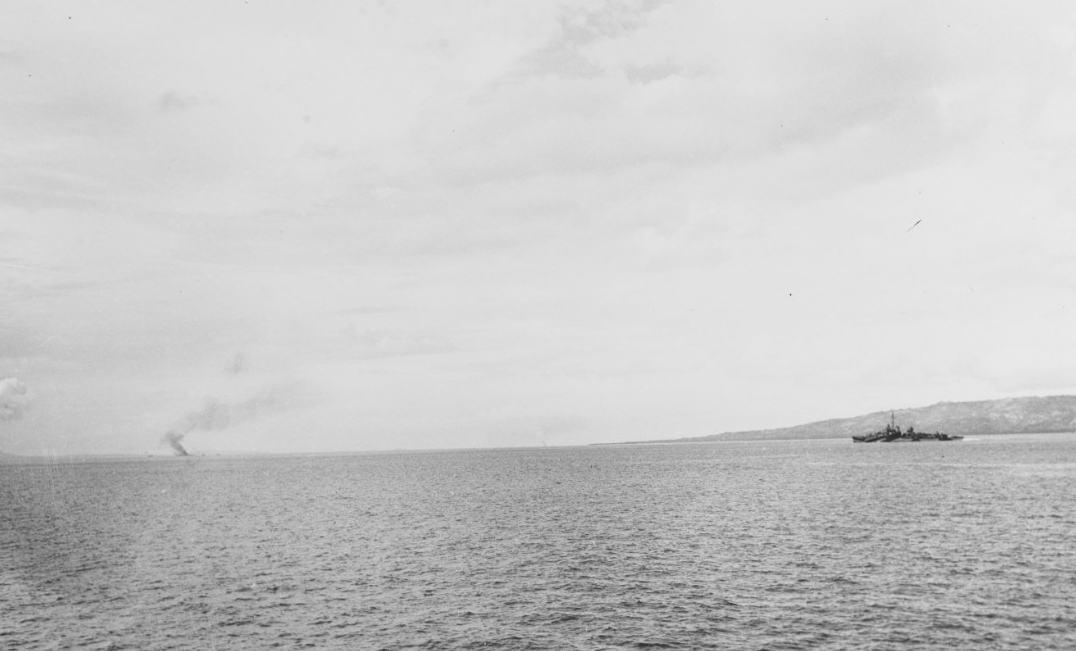
The destroyers Walke (DD-723) and Lamson arrived on the scene to begin picking up the survivors. Despite the devastating hits from three kamikazes and ensuing fires onboard, casualties proved comparatively light. Losses included six men, one officer and five enlisted, listed as missing in action, and 31 crewmembers wounded, with only 13 requiring hospitalization. Minutes after the last survivor left the ship, Walke scuttled Mahan with a combination of torpedoes and gunfire.
Recommended for a Silver Star award for Mahan’s successful bombardment of Cape Gloucester on 26 December 1943, Lt. Cmdr. Campbell received the medal for his actions during the kamikaze attack and subsequent sinking of his ship on 7 December 1944.
Mahan was stricken from the Navy Register on 20 January 1945.
Mahan received five battle stars for her World War II service.
| Commanding Officers | Date Assumed Command |
| Cmdr. John B. W. Waller | 18 September 1936 |
| Lt. Cmdr. Herbert G. Hopwood | 23 November 1937 |
| Lt. Cmdr. John H. Leppert | 16 July 1939 |
| Lt. Cmdr. Rodger W. Simpson | 5 April 1941 |
| Lt. Cmdr. James T. Smith | 23 March 1943 |
Cmdr. Earnest G. Campbell |
18 December 1943 |
Guy Joseph Nasuti
18 November 2019

